Selina Concise Biology Class 10 Book Chapter 13 - Free PDF solutions
Updated ICSE Class 10 Biology Chapter 13 - The Reproductive System Selina Solutions are provided by Vedantu in a step by step method. Selina is the most famous publisher of ICSE textbooks. Studying these solutions by Selina Concise Biology Class 10 Solutions, which are explained and solved by our subject matter experts, will help you in preparing for ICSE exams. Concise Biology Class 10 ICSE Solutions can be easily downloaded in the given PDF format. These solutions for Class 10 ICSE will help you to score good marks in ICSE Exams.
Access ICSE Selina Solutions for Grade 10 Biology Chapter No. 13 - The Reproductive System
Progress Check Page No.170-:
1. Tick mark the correct meaning of reproduction
i) Increase in population
ii) Increase in the number of parents
iii) Production of new individual of the same kind
iv) Production of identical individuals
Ans: The correct answer is (iii)
Reproduction is defined as the process which involves the production of new offspring that can be more (asexual) or less(sexual) similar to its parents.
2. State briefly the function of each of the following
i) Seminal vesicles
Ans: It produces the secretions that serve as a medium for the transportation of the sperms.
ii) Prostate gland
Ans: It produces the alkaline secretions that neutralize the acid in the female’s vagina.
iii) Cowper’s gland
Ans: It produces certain kind of secretions that act as the lubricant.
iv) Sperm duct (Vas deferens)
Ans: It transports mature sperm to the urethra in preparation for ejaculation.
Progress Check Page No.173
State Whether the Following Statements Are True (T) or False (F) :
i) One egg is released from each of the two ovaries every month.
Ans: This statement is false.
One egg is released from either of the two ovaries every month.
ii) The enlarged mature follicle burst to release the egg.
Ans: This statement is true.
iii) The egg is passed down through the oviduct by the muscular contractions.
Ans: This statement is false.
The egg is passed down through the oviduct by the ciliary muscles
iv) Clitoris is equivalent to male penis.
Ans: This statement is true
v) The vagina is a muscular tube.
Ans: This statement is true
Progress Check Page No. 179
1. Name the three main regions of human sperm & briefly mention the function of each.
Ans: Three main regions of human sperm are-:
1. Head-: It contains nucleus that is provided with haploid set of chromosomes. The acrosomal region of the head contains hydrolytic enzymes that play an important role in egg penetration.
2. Middle piece-: It contains mitochondria that provides the energy to the sperm.
3. Tail-: It helps the sperm to move forward.
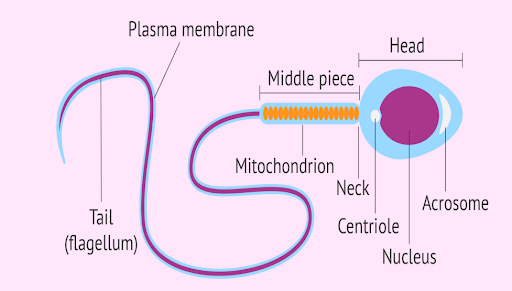
2. Name the Following-:
i) Three accessory glands of the human male reproductive system.
Ans: Accessory glands of the human male reproductive system are-:
1.Seminal vesicles
2.Prostate gland
3. Cowper’s gland
ii) Two hormones secreted from human placenta.
Ans: Two hormones secreted from human placenta are-:
Estrogen
Progesterone
iii) Two types of twins.
Ans: Two types of twins are-:
1. Fraternal Twins-: Such type of twins are produced from the two eggs.
2. Identical Twins-: Such type of twins are produced from one egg.
iv) Two layers of the wall of uterus
Ans: Layers of the wall of uterus are-:
Perimetrium
Myometrium
Endometrium
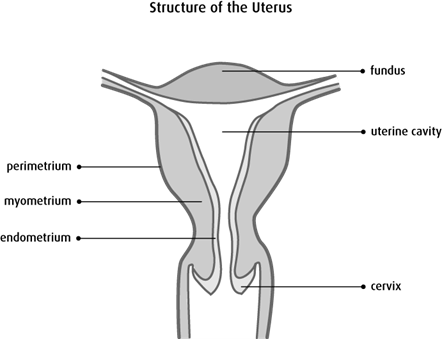
3. List the substances received by the foetus through the placenta.
Ans: The substances received by the foetus through the placenta are oxygen , glucose , amino acids ,lipids ,vitamins etc.
4. How is the carbon dioxide & urea excreted by the foetus , removed?
Ans: The nitrogenous wastes that are formed inside the body of the fetus are transferred from its blood into the mother’s blood, through the placenta. This waste is then carried into the kidneys of the mother where it is excreted out of the body. Similarly the carbon dioxide is eliminated from the body through the lungs of the mother by the process of ventilation.
5. Write one sentence each using the following terms pertaining to reproduction in humans.
i) Gestation
Ans: Gestation is the period that an embryo requires to develop inside the female body.
ii) 280 days
Ans: 280 is the period of time after which the pregnancy delivery date is predicted starting from the last menstrual cycle.
iii) Head first
Ans: Head first is the position in which the baby is positioned for cephalic presentation.
iv) Placenta
Ans: Placenta is the temporary organ which develops inside the uterus of a female for nutritional purposes as well as for the elimination of waste products out of the body.
v) After birth
Ans: The postpartum period begins immediately after the childbirth as the mother's body, including hormone levels and uterus size, returns to a non-pregnant state.
vi) Tied & cut
Ans: After the childbirth umbilical cord cut & tied.
A. Multiple Choice Questions
1. Which one of the following is the correct route that a sperm follows when it leaves the testis of a mammal?
(a) Vas deferens $ \to $ epididymis $ \to $ urethra
(b) Urethra $ \to $ epididymis $ \to $ vas deferens
(c) Epididymis $ \to $ urethra $ \to $ vas deferens
(d) Epididymis $ \to $ vas deferens $ \to $ urethra
Ans: (d) Epididymis $ \to $ vas deferens $ \to $ urethra
2. When pregnancy does not occur, the life of corpus luteum is about:-
(a) 4 days
(b) 10 days
(c) 14 days
(d) 28 days
Ans: (d) 28 days
3. In females, after how much time after fertilization, does the fertilized egg get implanted in the uterine wall?
(a) Few months
(b) One month
(c) Three weeks
(d) About seven days
Ans: (d) About seven days
4. The middle piece of sperm provides:
(a) energy
(b) food
(c) gene
(d) chromosomes
Ans: (a) energy
5. The normal gestation period in humans is:
(a) 270 days
(b) 290 days
(c) 280 days
(d) 295 days
Ans: (c) 280 days
B. Very Short Answer Type
1. Name the following:
(a) The membrane which protects the fetus and encloses a fluid.
Ans: Amnion
(b) The canal through which the testes descend into the scrotum just before birth in a human male child.
Ans: Inguinal canal
(c) Uterine wall that is shed during menstruation.
Ans: Endometrium
(d) The minute finger-like projections of the placenta.
Ans: Villi
2. Rewrite the terms in the correct order so as to be in a logical sequence.
(a) Implantation, ovulation, childbirth, gestation, fertilization.
Ans: (a) Ovulation $ \to $ fertilization $ \to $ implantation $ \to $ gestation $ \to \;$childbirth
(b) Coitus, ovum, sperm, sperm duct, urethra, vagina.
Ans: (b) Sperm $ \to $ sperm duct $ \to $ urethra $ \to $ coitus $ \to $ vagina $ \to $ ovum
(c) Sperm duct, penis, testes, sperms, semen.
Ans: (c) Testes $ \to $ Sperms $ \to $ Sperm duct $ \to $ Semen $ \to $ Penis
(d) Puberty, menopause, menstrual, menarche, reproductive age.
Ans: (d) Menarche $ \to $ Puberty $ \to $ Reproductive age $ \to $ Menstruals $ \to $ Menopause
(e) Graafian follicle, Ostium, Uterus, Fallopian tube.
Ans: (e) Graafian follicle $ \to $ Ostium $ \to $ Fallopian tube $ \to $ Uterus
3. Give appropriate terms for each of the following:
(a) The onset of reproductive phase in a female.
Ans: Menarche
(b) Rupture of follicle and release of ovum from the ovary.
Ans: Ovulation
(c) Monthly discharge of blood and disintegrated tissues in human female.
Ans: Menstruation
(d) Process of fusion of ovum and sperm.
Ans: Fertilization
(e) Fixing of developing zygote (blastocyst) on the uterine wall.
Ans: Implantation
4. Match the items in column I with those in column II and write down the matching pairs (some may not match)
Column I | Column II |
(a) Acrosome | (i) An embryo which looks like human baby |
(b) Gestation | (ii) Luteinizing hormone |
(c) Menopause | (iii) Ovum producing cells |
(d) Foetus | (iv) Semen |
(e) Oogenesis | (v) Spermatozoa |
(f) Ovulation | (vi) Complete stoppage of menstrual cycle |
(vii) Time taken by a fertilized egg till the delivery of baby |
Ans: The correct matching is as follows:
Column I | Column II |
(a) Acrosome | (v) spermatozoa |
(b) Gestation | (vii) Time taken by a fertilized egg till the delivery of baby |
(c) Menopause | (vi) complete stoppage of menstrual cycle |
(d) Foetus | (i) An embryo which looks like human baby |
(e) Oogenesis | (iii) ovum producing cells |
(f) Ovulation | (ii) Luteinizing hormone |
(vii) Time taken by a fertilized egg till the delivery of baby |
5. Name the following:
(a) The body part in which the testes are present in a human male.
Ans: Scrotum
(b) The part where the sperms are produced in the testes.
Ans: Seminiferous tubules
(c) The fully developed part of the ovary containing a mature egg.
Ans: Graffian follicle
(d) The accessory gland in human males whose secretion activates the sperms.
Ans: Seminal vesicle
(e) The tubular knot fitting like a cap on the upper side of the testis.
Ans: Epididymis
6. Choose the odd one in each of the following:
(a) Oestrogen; progesterone, testosterone, prolactin
Ans: Prolactin
(b) Ovary; fallopian tube; ureter; uterus
Ans: Ureter
(c) Seminiferous tubule; ovum; epididymis; sperm duct; urethra
Ans: Ovum
(d) Sperm; implantation; fertilization; ovum; after birth
Ans: Sperm
(e) Relaxin; cervix dilates; amniotic sac ruptures; childbirth; follicle
Ans: Follicle
7. Choose the odd one in each of the following:
(a) Oestrogen; progesterone; testosterone; prolactin.
Ans: Testosterone
(b) Ovary; fallopian tube; ureter; uterus.
Ans: Ureter
(c) Seminiferous tubule; ovum; epididymis; sperm duct; urethra.
Ans: Ovum
(d) Sperm; implantation; fertilization; ovum; after birth.
Ans: After birth
C. Short Answer Type
1. State whether the following statements are TRUE (T) or FALSE (F):
(i) Fertilization occurs in vagina. (T/F)
Ans: False
(ii) Uterus is also known as the birth canal. (T/F)
Ans: False
(iii) Nutrition and oxygen diffuse from the mother's blood into the fetus's blood through amnion. (T/F)
Ans: False
2. Rewrite any two of the wrong statements by correcting only one word either at the beginning or at the end of the sentence.
Ans: The corrected word is highlighted in black color.
(i) Fertilization occurs in the fallopian tube.
(ii) Vagina is also known as the birth canal.
3. Complete the following table by writing the name of the structure or the function of the given structure:
Structure | Function |
1. Corpus luteum | 1. ------- |
2. ------- | 2. produces male gametes in mass |
3. Placental disc | 3. ------- |
4. ------- | 4. increases the force in uterine contractions |
5. Umbilical cord | 5. ------- |
6. Fallopian tube | 6. ------- |
Ans: The answer to the blanks is written in the table.
Structure | Function |
1. Corpus luteum | 1. secretes progesterone & other hormones to prepare the uterine wall for the receivable of the embryo. |
2. Testes | 2. produces male gametes in mass |
3. Placental disc | 3. supplies oxygen and nutrients to the embryo |
4. Oxytocin | 4. increases the force in uterine contractions |
5. Umbilical cord | 5. connects placenta with fetus |
6. Fallopian tube | 6. The site of fertilization for the sperm and ovum |
4. Given below are the names of certain stages/substances related to reproduction and found in the human body.
(a) Foetus
Where is it contained?
How does it differ from an embryo?
Ans: (a) Foetus:
It is contained in the uterus.
In the foetus, limbs have appeared and resemble humans, unlike the embryo which is a growing or dividing zygote.
(b) Hyaluronidase
Is it an enzyme or simply a protein?
What is its function?
Ans: (b) Hyaluronidase:
Enzyme
It is an enzyme secreted by the sperm that allows the sperm to penetrate the egg.
(c) Morula
What is this stage?
Name the stage which comes next to it.
Ans: (c) Morula:
It is the stage in the development of the human embryo which consists of a spherical mass of cells. Blastocyst
(d) Amniotic fluid
Where is it found?
What are its functions?
Ans: (d) Amniotic fluid:
Between amnion and embryo
It protects the embryo from physical damage, keeps the pressure all around the embryo and prevents the sticking of the foetus to the amnion.
(e) Placenta
What are the two sources that form the placenta?
Name any two main substances which pass from the foetus to the mother through the placenta.
Name any two hormones it produces.
Ans: (e) Placenta:
The sources that form placenta are two sets of minute finger-like processes called the villi. One set of villi is from the uterine wall and the other set is from the allantois.
Oxygen and amino acids.
Progesterone and oestrogen.
(f) Implantation
The development stage that undergoes this process.
The approximate time after fertilization, when it occurs.
Ans: (f) Implantation:
Blastocyst
It occurs about 5-7 days after ovulation.
5. Describe the functions of the following:
(a) Inguinal canal
Ans: (a) Inguinal canal: It is the canal which allows the descent of testes along with their ducts, blood vessels and nerves into the abdomen.
(b) Testis
Ans: (b) Testis: Testis is a male reproductive organ. There a pair of testes present in a scrotal sac descended outside the body cavity. Testes produce sperm which are the male gametes.
(c) Ovary
Ans: (c) Ovary: Ovary is a female reproductive organ. It produces ova i.e. female gametes.
(d) Oviduct
Ans: (d) Oviduct: A pair of oviducts are present on either side of the uterus. The oviduct carries the released ovum from the ovary to the uterus.
6. Differentiate between:
(a) Semen and sperm
Ans:
(a) Differences between semen and sperm:
Semen | Sperm |
Semen is a milky white fluid. It contains sperms and secretions of seminal vesicles. | Sperms are human male gametes which are produced in the testes. |
(b) Hymen and clitoris
Ans: (b) Differences between hymen and clitoris:
Hymen | Clitoris |
Hymen is a thin membrane that partially covers the opening of vagina in young females. | Clitoris is a small erectile structure located in the uppermost angle of vulva in front of the urethral opening. |
(c) Uterus and vagina
Ans: (c) Differences between uterus and vagina:
Uterus | Vagina |
Uterus is a hollow, pear shaped muscular organ located in the pelvic cavity. | Vagina is the muscular tube extending from the cervix to the outside. |
It is the site of implantation for the embryo after fertilization. | The vagina receives the male penis and provides entry for the sperms at the time of sexual intercourse. |
(d) Efferent duct and sperm duct
Ans: (d) Differences between efferent duct and sperm duct:
Efferent Duct | Sperm Duct |
Efferent ducts join to form the epididymis. | Epididymis is continued by the side of the testes to give rise to the sperm duct or vas deferens. |
(e) Follicle and corpus luteum
Ans: (e) Differences between follicle and corpus luteum:
Follicle | Corpus luteum |
A maturing egg contained in a cellular sac is called the follicle. | The remnant of the ruptured follicle persists and gets converted into a yellow mass called corpus luteum. |
(f) Amnion and allantois
Ans: (f) Differences between amnion and allantois:
Amnion | Allantois |
Amnion is a sac which develops around the embryo before the formation of allantois. | Allantois is an extension from the embryo which forms villi of placenta. |
(g) Prostate gland and Cowper's gland
Ans: (g) Differences between prostate gland and Cowper's gland:
Prostate Gland | Cowper's Gland |
Prostate gland surrounds the urethra in males. | Cowper's gland opens into urethra in human males. |
Its alkaline secretion neutralizes acid in the female's vagina. | Its secretion serves as a lubricant. |
D. Descriptive Type
1. Define the following terms:
(a) Reproduction
Ans: (a) Reproduction: By the process of reproduction new individuals are formed. The process of reproduction can be sexual and asexual in different organisms.
(b) Hernia
Ans: (b) Hernia: Hernia is an abnormal condition which is caused when the intestine due to the pressure in the abdomen bulges into the scrotum through the inguinal canal.
(c) Ovulation
Ans: (c) Ovulation: Ovulation is the release of the mature ovum by the rupture of the Graafian follicle.
(d) Puberty
Ans: (d) Puberty: Puberty is the period during which the immature reproductive system in boys and girls matures and becomes capable of reproduction.
(e) Fertilisation
Ans: (e) Fertilisation: The fusion of the male gamete (sperm) and the female gamete (ovum) to form a zygote is called fertilisation.
(f) Hymen
Ans: (f) Hymen: Hymen is a thin membrane that partially covers the opening of the vagina in young females.
2. Distinguish between the following pairs:
(a) Spermatogenesis and oogenesis
Ans:
(a) Differences between spermatogenesis and oogenesis:
Spermatogenesis | Oogenesis |
It is the process of production of sperms in seminiferous tubules of testes. | It is the growth process in which an ovum becomes a mature egg. |
(b) Implantation and gestation
(b) Differences between implantation and gestation:
Implantation | Gestation |
It is the fixing of the blastocyst to the endometrial lining of the uterus or the wall of the endometrium. | It is the time period of development of the embryo in the uterus. |
(c) Pregnancy and parturition
(c) Differences between pregnancy and parturition:
Pregnancy | Parturition |
It is the state of carrying a developing embryo or a foetus within the female body. | It is the process of giving birth to the young ones at the end of the gestation period. |
(d) Placenta and umbilical cord
(d) Differences between placenta and umbilical cord:
Placenta | Umbilical cord |
It is a disc-like structure attached to the uterine wall. | It is a cord containing blood vessels which connects the placenta with the foetus. |
(e) Identical and fraternal twins
(e) Differences between identical and fraternal twins:
Identical twins | Fraternal twins |
They are produced from one ovum i.e. one developing zygote splits and grows into two fetuses. | They are produced when two ova get fertilized at a time. |
(f) Menarche and menopause
(f) Differences between menarche and menopause:
Menarche | Menopause |
It is the onset of menstruation in a young female at about the age of 13 years. | It is the permanent stoppage of menstruation in females at about the age of 45 years. |
3. What is the significance of the testes being located in the scrotal sacs outside the abdomen? Can there be any abnormal situation regarding their location? If so, what is that and what is the harm caused due to it?
Ans: Testes are responsible for the production of male gametes i.e. sperms. The normal body temperature does not allow the maturation of the sperms. Being suspended outside the body cavity, the temperature in the scrotal sac is 2 to 3oC which is the suitable temperature for the maturation of the sperms.
When it is too hot, the skin of the scrotum loosens so that the testes hang down away from the body. When it is too cold, the skin contracts in a folded manner and draws the testes closer to the body for warmth.
In an abnormal condition, in the embryonic stage, the testes do not descend into the scrotum. It can lead to sterility or incapability to produce sperms.
4. Suppose a normal woman has never borne a child. How many mature eggs would she have produced in her lifetime? Your calculation should be based on two clues:-
(a) Eggs are produced at the rate of 1 egg every 28 days (one menstrual cycle)
(b) A woman's total reproductive period is 13-45 years.
Ans: (a) Total reproductive period = 45 - 13 = 32 years
(b) Total eggs produced = 32 x 12 = 384 eggs approximately
5. What are the secondary sexual characters in the human male and female respectively?
Ans: The secondary sexual characters in males are:
(i) Beard and moustache
(ii) Stronger muscular built
(iii) Deeper voice
The secondary sexual characters in females are:
(i) Breasts in females
(ii) Large hips
(iii) High pitched voice
6. What are the accessory reproductive organs?
Ans: The accessory reproductive organs include all those structures which help in the transfer and meeting of two kinds of sex cells leading to fertilization and growth and development of egg up to the birth of the baby.
For example: uterus in females, penis in males.
7. Differentiate between the primary and accessory reproductive organs.
Ans: The difference between primary and accessory reproductive organs are:
Primary Reproductive Organs | Accessory Reproductive Organs |
|---|---|
The primary reproductive organs produce sex cells. | The accessory reproductive organs help in the transfer and meeting of two kinds of sex cells leading to fertilization. |
The primary reproductive organs do not help in the development of a baby. | The accessory organs help in the growth and development of eggs up to the birth of baby. |
Example: Testes in males and ovaries in females. | Example: penis in males, Uterus, vagina in female. |
8. Name and describe very briefly, the stages in the development of the human embryo.
Ans: The stages are described below in point forms:
(a) After fertilization zygote is formed inside the fallopian tube.
(b) The zygote then divides repeatedly to form a spherical mass of cells known as 'Morula'.
(c) The morula then develops into a hollow sphere of cells with a surrounding cellular layer and an inner cell mass projecting from it centrally. This stage is known as the 'blastocyst'. It implants itself into the uterine wall.
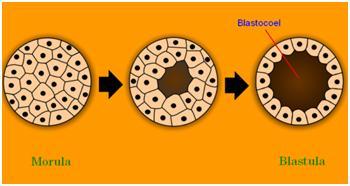
(d) From the blastocyst arises an embryo which is around 3 weeks old. It is a tiny organism that hardly resembles human beings.
(e) By the end of 5 weeks, the embryo is with a developed heart and blood vessels.
(f) By the end of 8 weeks, limbs are developed. This stage is known as 'foetus'.
(g) At the end of nearly 40 weeks i.e. end of gestation period, the infant is born.
9. Is it correct to say that the testes produce testosterone? Discuss.
Ans: Testosterone is the male reproductive hormone produced by the interstitial cells or the Leydig cells. These cells are located in the testes. They serve as a packing tissue between the coils of the seminiferous tubules. Therefore, it can be said that the testes produce the male hormone testosterone.
E. Structure/application/skill Type
1. Given below is a diagram of two systems together in the human body.
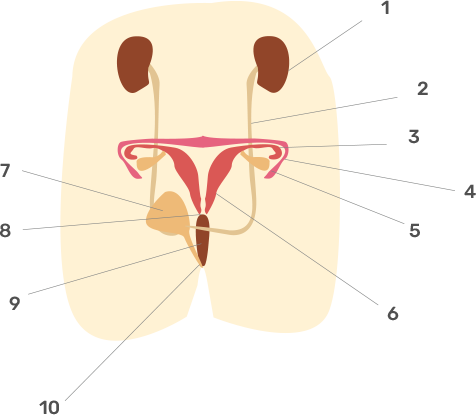
(a) Name the systems.
(b) Name the parts numbered 1-10.
(c) Describe the functions of the parts 3, 4, 5 and 6.
(d) What will happen if part 3 on both sides gets blocked?
Ans:
(a) The systems are the excretory system and Female Reproductive system.
(b)
1 | Kidney |
2 | Ureter |
3 | Fallopian Tube |
4 | Infundibulum |
5 | Ovary |
6 | Uterus |
7 | Urinary Bladder |
8 | Cervix |
9 | Vagina |
10 | Vulva |
(c) Function of fallopian Tube (part 3): The fallopian tubes carry the ovum released from the ovary to the uterus.
Function of infundibulum (part 4): Infundibulum is the funnel shaped distal end of the ovary which picks up the released ovum and pushes it further on its passage into the fallopian tube.
Function of ovary (part 5): Ovary produces female gametes i.e. ova.
Function of uterus (part 6): Uterus allows the growth and development of the embryo.
(d) If the fallopian tube (part 3) on both sides gets blocked, the ovum released by the ovary will not be pushed into the oviduct and hence, there will be no possibility of fertilisation.
2. The following diagram represents the vertical sectional view of the human female reproductive system.
(a) Label the parts indicated by the guidelines 1 to 8.
(b) How does the uterus prepare for the reception of zygote?
(c) What happens to the uterus, if fertilization fails to take place?
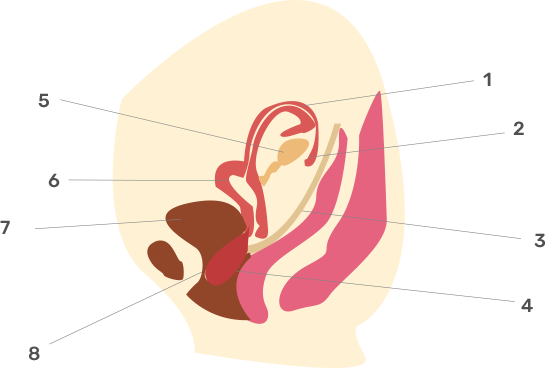
Ans:
(a)
1 | Fallopian Tube |
2 | Infundibulum |
3 | Ureter |
4 | Vagina |
5 | Ovary |
6 | Uterus |
7 | Urinary Bladder |
8 | Urethra |
(b) Oestrogen secreted by the corpus luteum secretes oestrogen. Oestrogen stimulates the thickening of the endometrial wall of the uterus. The uterine wall becomes thickened and is supplied with a lot of blood to receive the fertilized egg.
(c) If fertilization fails to take place, the endometrial lining of the uterus starts shedding on the 28th day of the menstrual cycle. Finally it is discharged out along with the unfertilised ovum as the menstrual flow.
3. Given below is the schematic diagram of the sectional view of the human male reproductive system.

a. Name the parts numbered 1-11.
b. State the functions of the parts numbered 1, 2, 3, 5, 8 and 11.
Ans: The parts are:
a. 1 - Seminal vesicles
2 - Prostate gland
3 - Bulbo-urethral gland
4 - Epididymis
5 - Testis
6 - Scrotum
7 - Urinary bladder
8 - Vas deferens
9 - Erectile tissue
10 - Penis
11 - Urethra
Ans: b. The functions of the parts are:
i. Seminal Vesicles
They produce the fluid which serves as the transporting medium for sperms.
ii. Prostate Gland
It produces an alkaline secretion which mixes with the semen and helps neutralise the vaginal acids.
iii. Bulbo-urethral Gland
It produces a secretion which serves as a lubricant for the semen to pass through the urethra.
iv. Testis
It produces the male gamete sperm and the male sex hormone testosterone.
v. Vas Deferens
They carry the sperms from the epididymis to the urethra.
vi. Urethra
It serves as an outlet for delivering the sperms into the vagina.
4. The diagram below represents two reproductive cells A and B. Study the same and then answer the questions that follow:
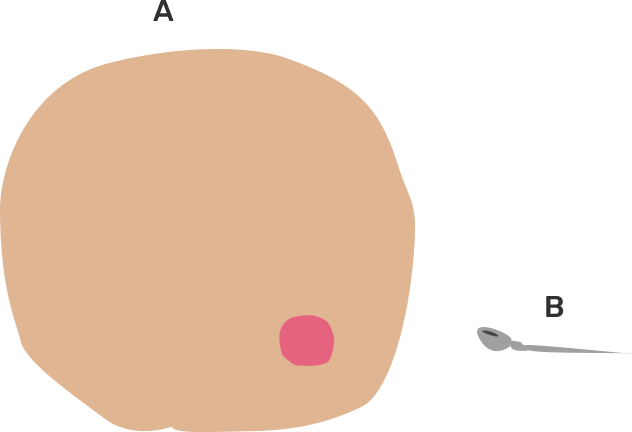
a. Identify the reproductive cells A and B
b. Name the specific part of the reproductive system where the above cells are produced.
c. Where in the female reproductive system do these cells unite?
d. Name the main hormone secreted by the (1) ovary (2) testes.
e. Name an accessory gland found in the male reproductive system and state its secretion.
Ans:
a. A - ovum
B - sperm
b. Sperms are produced in the testis.
The ovum is produced in the ovary.
c. The reproductive cells unite in the fallopian tubes of the female reproductive system.
d. Ovary - Oestrogen and progesterone
Testis - Testosterone
e. Accessory glands:
• Seminal Vesicle - Seminal fluid
• Prostate Gland - Alkaline secretion
• Bulbo-Urethral Gland - Lubricant
5. The diagram given below is that of a developing human foetus in the womb. Study the same and answer the questions that follow:
(a) Name the parts '1' to '5' indicated by guidelines.
(b) What term is given to the period of development of the foetus in the womb?
(c) How many days does the foetus take to be fully developed?
(d) Mention two functions of the parts labelled '2' other than its endocrine functions.
(e) Name (any one) hormone produced by the part labelled '2'.
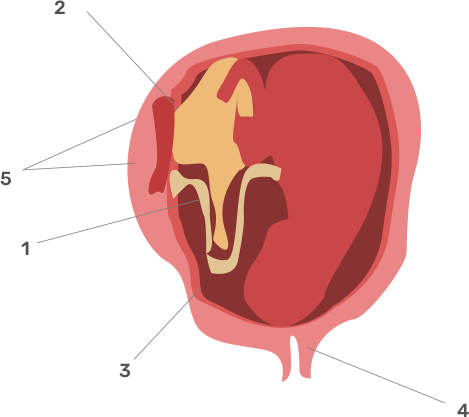
Ans: The parts are:
(a) 1 - umbilical cord,
2 - placenta,
3 - amnion,
4 - mouth of the uterus,
5 - a muscular wall of the uterus
Ans: (b) Gestation
Ans: (c) 280 days
Ans: (d) Placenta provides the foetus with oxygen and nutrients. In addition, the placenta also removes carbon dioxide and waste products of the foetus.
Ans: (e) Progesterone
6. Given below is a portion of the diagram to show the diagrammatic highly magnified view of a single human sperm. Complete the diagram to show its internal structure.
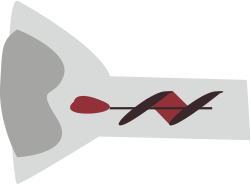
Ans:
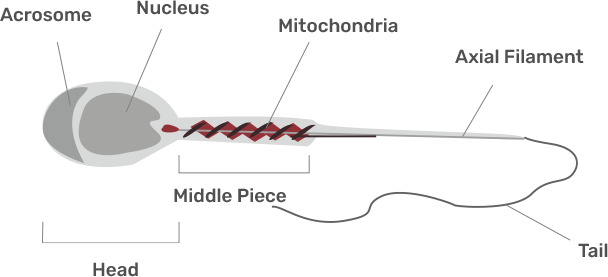
7. Given below is the outline of the male reproductive system. Name the parts labelled 1 to 8 and state their functions. Also, name the corresponding structure of part (4) in the female reproductive system.
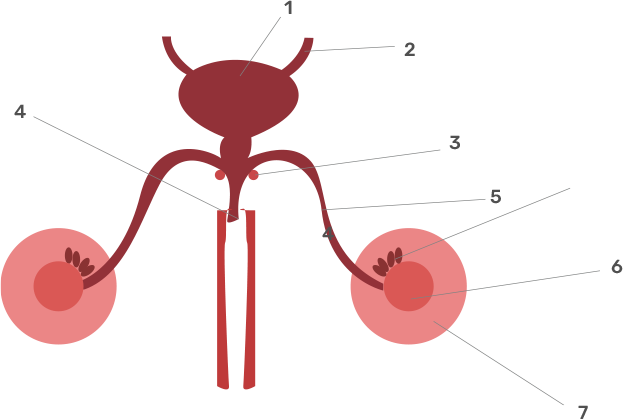
Ans:
Part | Functions |
1. (Urinary bladder) | Stores urine |
2. (Ureter) | Carries urine from the urinary bladder to the urethra |
3. (Bulbo-urethral glands) | Secretion serves as a lubricant |
4. (Sperm duct/Vas deferens) | Allows the transit of sperms from the testicles to the outside of the body Allows maturation of sperm cells |
5. (Urethra) | Carries urine from the bladder to outside of the body Ejaculation of semen when the male reaches orgasm |
6. (Testis) | Production of sperms |
7. (Scrotum) | Protects the testes Acts as a climate control system for the testes |
8. (Epididymis) | Stores and allows the maturation of sperms before release |
Fallopian tubes (oviducts) in females are analogous to sperm ducts in males. Sperm ducts carry sperms to the urethra, while fallopian tubes carry ova to the uterus.
Why Choose Vedantu for Selina Class 10 Biology solutions?
At Vedantu we get step by step solutions for all the questions in the Selina Concise Biology Class 10 book for free in PDF format. The questions are solved and explained in detail by experts who have knowledge in the field of biology. By studying the Concise Biology Solutions, the students can easily answer the questions given in the examination and score really good marks.
A Brief Introduction of the Chapter The Reproductive System
This chapter deals with the reproductive system, one of the most important chapters that the student needs to know from both exam and knowledge point of view. In this chapter the students learn about both sexual and asexual reporduction. They learn how new individuals are formed in different organisms. The chapter covers information which is useful for every human being. The chapter not only involves the process of reproduction, it also involves their characteristics, role of different hormones and how each reproduction is different from another.
What are the Benefits of Using Concise Biology Solutions?
Selina's Concise Biology Class 10 solutions will help students learn and understand the chapter well. Here is a list of the benefits of studying 10 brief solutions to Selina biology class.
The 10 ICSE solutions in the biology class present an alternative approach to the study and review of biology. The solutions give students a brief overview of the chapters to gain a deeper insight into the topics.
Class 10 Summary Biology ICSE Solutions 2024-25 is informative as it presents all the solving exercises in the Biology chapters in detail and saves a lot of time while preparing for the exams.
Scientific experts prepare chapter solutions to guide students to study the chapter immediately. Selina's Concise Biology Class 10 solutions are available free of charge and students can find their solutions anywhere.
The updated solutions for Selina textbooks are created in accordance with the latest syllabus. These are provided by Vedantu in a chapter-wise manner to help the students get a thorough knowledge of all the fundamentals. Download the solution for this chapter today and make your study sessions more fruitful. Clarify your doubts in no time and continue with your study without any hindrance. Learn how the experts have followed the ICSE Board guidelines to compile the answers and score better in the board exams.
FAQs on Fast Learning with Selina Concise Biology Class 10 ICSE Solutions for Chapter 13 - The Reproductive System
1. What types of questions can we find in the Class 10 Biology solutions?
Selina Concise Biology Class 10 solutions are available in PDF format. ICSE Class 10 biology solutions can be downloaded for free and are also easily available on laptops, desktops, tablets, or smartphones. PDF files consist of multiple-choice questions, short answer questions, short answer questions, long answer questions, and application or structured and skill questions. Students will get solutions to all the questions asked in Chapter 13. Through the solutions, the students can easily acquire knowledge about their queries which will benefit them to learn more new things.
2. How does the Class 10 Biology solution help the students?
Solutions for 10th-grade biology will help students in-depth learning of the subject and chapter topics. ICSE Class 10 Biology Solutions are available and available for free download. ICSE solutions will help students act as a conceptual guide for students from the very beginning. Experienced science teachers prepare chapter solutions that guide students in learning the chapter immediately. These solutions are essential study materials that will help students obtain good grades on the exam. These solutions also help the students in their self-study.
3. Is Selina Concise Biology Class 10 ICSE Solutions for Chapter 13 - The Reproductive System better to clear the biology exam of ICSE class 10?
There are plenty of sources online from where you can download the solution for the Selina book on biology. But the student needs to ensure that the solution they are referring to is accurate and keeps the student’s best interest in mind. Another point the students need to keep in mind is that they should not follow too many books as this will lead to confusion. The best solution book available for the student is available for free on the Vedantu website. They are easy to download and can easily be utilized by students without any hassle.
4. Where can the students get the Selina Concise Biology Class 10 ICSE Solutions for Chapter 13 - The Reproductive System?
Since the 10th board is one of the most important examinations, it's important that the materials we follow are 100 percent accurate. Vedantu is one of the most reliable sources for the 10th board preparation. The PDF file for this chapter’s solutions can be downloaded for free. Apart from the solutions, students can also get model question papers, sample papers, previous year questions, and the syllabus can help the students in their preparation. Students can also practice questions from the sample papers available on the Vedantu website to get a proper insight into the examination.





































